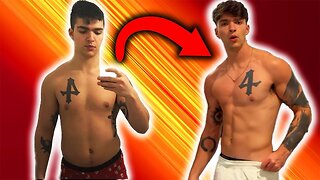How Many Wires Can Fit in Each Hole?
When roughing in for new residential wall rough, does it really matter how many pieces of NM cable we put into each hole drilled thru the studs? In the latest episode of Electrician U, Dustin answers this question and brings to light some of the code articles associated with it.
🤘⚡️MEMBERSHIP⚡️🤘
JOIN ELECTRICIAN U - become a member and get:
FREE Continuing Education every year
FREE Practice Exams
FREE Monthly Video Courses
FREE Weekly Live Instructor-Led Classes
FREE Monthly Educational Newsletter
Premium Members-Only Content
Private Discord Channel
Monthly Members-Only Discord Chats
Sign up here --- https://www.electricianu.com/electrician-u-membership/
🎧🎹MUSIC AND VIDEO:🎹🎧
https://www.facebook.com/descantmv
🎬✍️ART AND ILLUSTRATION:✍️🎬
https://www.daverussoart.com
The very first thing to mention would be your local AHJ. The Authority Having Jurisdiction. That usually is your local inspector. They have the final say on approving your installation or not, so it makes sense to see what they are requiring, before just going out and doing! Some inspectors like no more than a couple, while some allow you three, etc. The last thing you want to do is rough in an entire house only to find out that the inspector won’t pass your wall rough, and you must do a bunch of rework! Trust me here, its no fun and can be quite aggravating (as well as expensive).
The NEC doesn’t specifically talk about how many wires you can install in a given size hole in a stud. And that also makes sense when you think of how many different sizes of holes you could drill in a stud. What the NEC DOES talk about that is related to the topic is cable bundling. If you were to install a bunch of NM cables together thru the wood studs and tie wrap them every few feet, it may look nice and neat but there are a few issues with an installation like that. The first would be heat dissipation. With so many cables that close together, they cannot dissipate the heat generated by the flow of current in them. This can be a point of contention to some of us. The likelihood of ALL those NM cables being run at FULL CAPACITY at the same time is pretty low, so is the need to dissipate a TON of heat really that important?
The more likely reason the NEC doesn’t allow us to bundle (without derating) is due to capacitive coupling. When you have two conductors run next to one another and an air gap in between them, you have the ability to build up capacitance. Capacitance is the ability of a component or circuit to collect and store energy in the form of an electrical charge. So, the theory here is the more space you provide between those conductors, the more you can reduce the effects of that capacitance. That capacitance CAN impede current flow in the conductors. If you had 10 cables bundled together, with 10 different amounts of current flow running thru them, all that capacitance can have a large adverse effect on the current flow. Table 310.15(C)(1) of the NEC is where we derive the values that we must derate our conductors when we install several of them together in a conduit or thru the wood studs of a wall, or things like that. The NEC doesn’t tell us that we CAN’T install many cables closely together, just that when we do, we may have to adjust our conductors to be able to carry less amperage than standard wire sizes normally allow.
So, in a nutshell, NO, the NEC doesn’t tell us how many conductors we can put in any given size hole in a stud. The larger the hole, the more cables you can fit in there. And the larger the hole, the less chance of you damaging the NM cable when pulling it thru the hole drilled in the studs. Don’t make the hole so small that it takes a truck to pull it in there, but not so big as to damage the studs. In fact, Article 300.4(A)(1) of the NEC tells us that if we drill holes in the studs for NM cable, that we cannot be closer than 1-1/4” to the nearest edge of the wood member, and that if we DO put them closer than that, we must install nail plates to protect the cables from screws, nails, or things like that! Bottom line is to plan your work and install the cables without damaging them.
We hope this sheds some light on the subject. We would love to hear your thoughts on cable bundling, heat dissipation, and capacitance. Leave your comments below in the comment section! Please continue to follow Electrician U and Dustin as we are constantly adding new content for our viewers!
-
 0:56
0:56
Electrician U
6 months ago90° Drill Attachment!!! - What Hand Tools Are YOU Missing
5.11K1 -
 4:48:29
4:48:29
LumpyPotatoX2
8 hours ago$10,000 PUBG Tournament w/GamersError - #RumbleTakeover
30K9 -
 3:22
3:22
One Bite Pizza Reviews
2 days agoBarstool Pizza Review - Marco Pizzeria & Restaurant (Branford, CT)
35.1K23 -
 41:46
41:46
Standpoint with Gabe Groisman
13 hours agoEp. 27. From GameStop to the NBA. Gabe Plotkin
33.5K3 -
 55:04
55:04
Matt Kohrs
10 hours agoThe Volatile Week Ahead || The MK Show
51.4K23 -
 26:18
26:18
Stephen Gardner
9 hours agoTop Republican UNLOADS on Democrats and Biden's MENTAL HEALTH!!
64.8K107 -
 44:30
44:30
Michael Franzese
2 days agoCancel Culture Backlash of My UK Tour | Michael Franzese
127K50 -
 35:12
35:12
Island Hopper TV
1 day agoFull Costa Rica Travel Guide 2024
84.7K33 -
 4:43
4:43
ParisDemers
1 day agoThis Diet Hack Changed My Life! (How To Get Ripped FAST!)
91.7K30 -
 46:57
46:57
Crime Circus
1 day agoApple River ST*BBING!! Stand Your Ground Interrogation of Man in Wisconsin
93.9K46